Factors affecting eggshell quality in laying hens
Eggshell quality is key to the profitability of farming. Special attention must be paid to the egg quality, as changes in eggshell quality are often the first sign of factors affecting the laying hens. The colour, texture, shape, size, and strength of an eggshell tell a story about the chicken and what has affected her during the 24 - 26 hours it takes for an egg to be formed. This article will give a brief overview of some common factors that can affect the eggshell quality of hens.
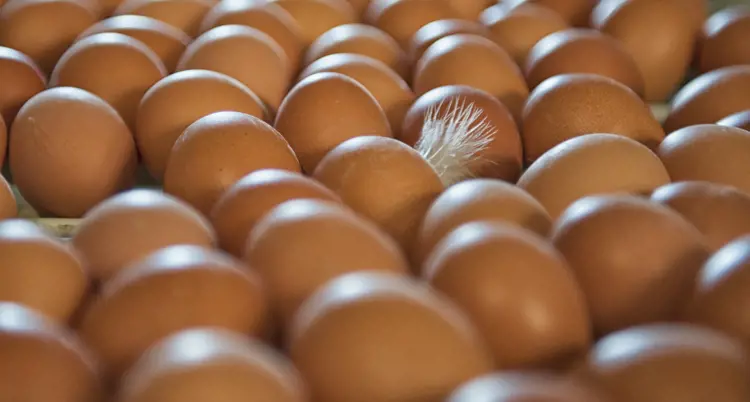
1. Stress
Chickens can be particularly vulnerable to environmental stress. The eggshell is formed by the activity of the cells located in the hen’s reproductive tract, particularly the oviduct and uterus. When hens are affected by stress, the cells’ secretions can become acidic and damage or destroy the cells themselves. This in turn affects the eggshell quality and can manifest in different eggshell problems depending on the cause of stress.
Stress caused by relocation or disturbances during calcification can cause excess calcium coatings on the eggshell (see Figure 1). Moving birds during peak laying times can frequently impact the quality of the egg. Stress can also interrupt normal calcification and cause two eggs to come into contact with one another in the shell gland. This can cause a white band to form (see Figure 2) on the first egg from an extra layer of calcium that is deposited while the egg is retained in the egg pouch.
Figure 1: Calcium deposits Figure 2: White-banded Figure 3: Soft-shelled egg

Heat stress caused by high environmental temperatures (above 25°C) often contributes to increased eggshell problems, particularly in summer months. High temperatures will cause chickens to reduce their feed intake and increase panting to keep themselves cool. Panting reduces the carbon dioxide (CO2) in the blood, thus increasing the pH and alkalinity of the blood in a condition called respiratory alkalosis.
The availability of calcium for the eggshell is reduced, the acid-base balance of the body is disturbed, and the condition can cause an increase in soft-shelled (see Figure 3) and cracked eggs.
It is important to note that any eggshell quality problem may be caused by more than one factor. Any condition that makes the eggshell weaker will increase the percentage of eggs (Figure 4 – 6) with micro-cracks, with heat stress being the most notable source of concern. Cracks can also be caused by mechanical damage, a collision between eggs or hard surfaces during the laying or egg collection process. Some viral diseases, overcrowding, washing of eggs and drinking water with high levels of salt can also contribute to the percentage of cracked eggs found on a farm.
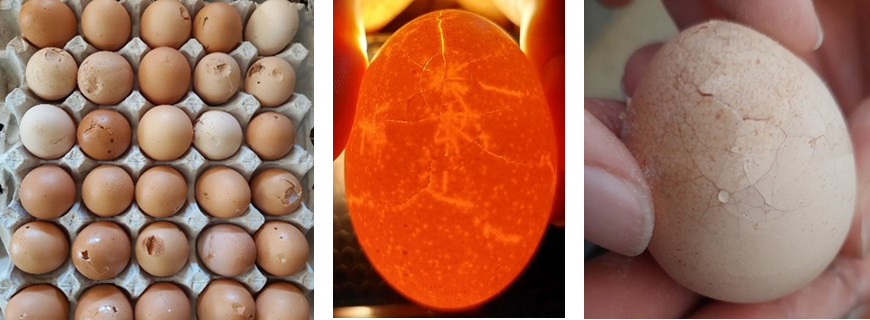 Figure 4: Cracked eggs Figure 5: Large cracks Figure 6: Star cracks
Figure 4: Cracked eggs Figure 5: Large cracks Figure 6: Star cracks
2. Bird health & disease
If a bird is affected by a prolapsed cloaca and possibly vent-pecking or cannibalism, the first sign in the shed may be a blood-smeared egg. Injured hens tend to crouch down and hide, so spotting blood-stained eggs can help to identify, isolate, and treat injured birds on the farm early. The danger of vent-pecking and cannibalism is that it is a learned behaviour that can be triggered by stress or boredom and can spread through a poultry shed and cause high mortalities if not adequately controlled.
Another common eggshell problem is the occurrence of pale or white-shelled eggs. If a laying flock that usually produces brown eggs, suddenly starts producing a large quantity of white eggs (see Figure 8), it could be caused by infectious bronchitis (IB). While it may be an early indicator of disease, it can also be a symptom of a live vaccine, as is often observed after administering an IB/ND live vaccine as part of a vet-recommended vaccination program.

Figure 7: Blood-stained egg
Shell-less eggs are defined by the lack of a shell, with the albumin and yolk only protected by a thin shell membrane. These eggs can occasionally be seen in young hens coming into lay due to an immature shell gland. However, large quantities of shell-less eggs, especially in established flocks, can be an early warning sign of disease, particularly Avian Influenza (AI). Newcastle Disease, egg drop syndrome and IB may also be the culprits causing a lack of eggshells. It is important to test birds thoroughly and quickly if this sign is prevalent to rule out disease as a cause.
Figure 8: Pale/white-shelled eggs
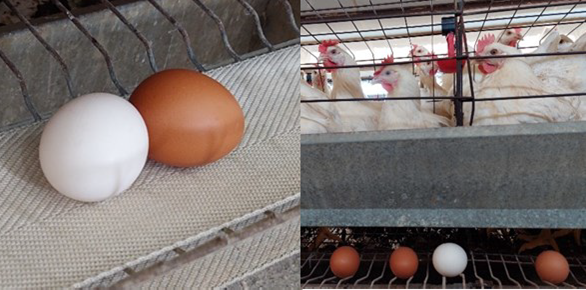
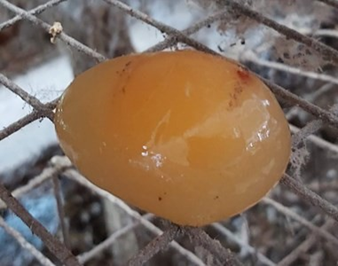
Figure 9: Shell-less eggs in the shed
3. Bird age
The age of the laying hen influences eggshell quality. Young point-of-lay hens will typically lay smaller, misshapen eggs due to an immature shell gland (see Figure 10; left). Older hens tend to lay larger eggs with relatively thin shells that break or crack (see Figure 4 - 6) more easily as the hen loses some of her ability to mobilize calcium from her bones with age to produce calcium carbonate for strong eggshells.
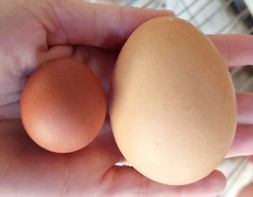
Figure 10: Misshapen eggs
4. Nutrition
The nutritional qualities of the feed consumed by layers are important for the formation of a high-quality egg. The balance of calcium and phosphorus, vitamin D3 and the complex relationship of these nutrients with the hormonal system of the layer in calcium metabolism during lay is vital. Feeding less than recommended amounts can cause nutritional imbalances, lower egg production and lower eggshell quality.
Conclusion
Paying attention to eggshell quality on the farm is crucial to identifying factors that may be affecting laying hens and ultimately the success of the farm. Good nutrition plays an important role in regulating hen performance and consequently eggshell quality. However, it is important to be aware of the many factors that can affect eggshell quality on farm to be able to identify what are normal variations in eggshells and to react, and treat quickly, if variations are a cause for concern.
Should you require more information relating to factors affecting eggshell quality in laying hens please contact your nearest De Heus Technical Specialist - https://www.deheus.co.za/meet-our-team/.
